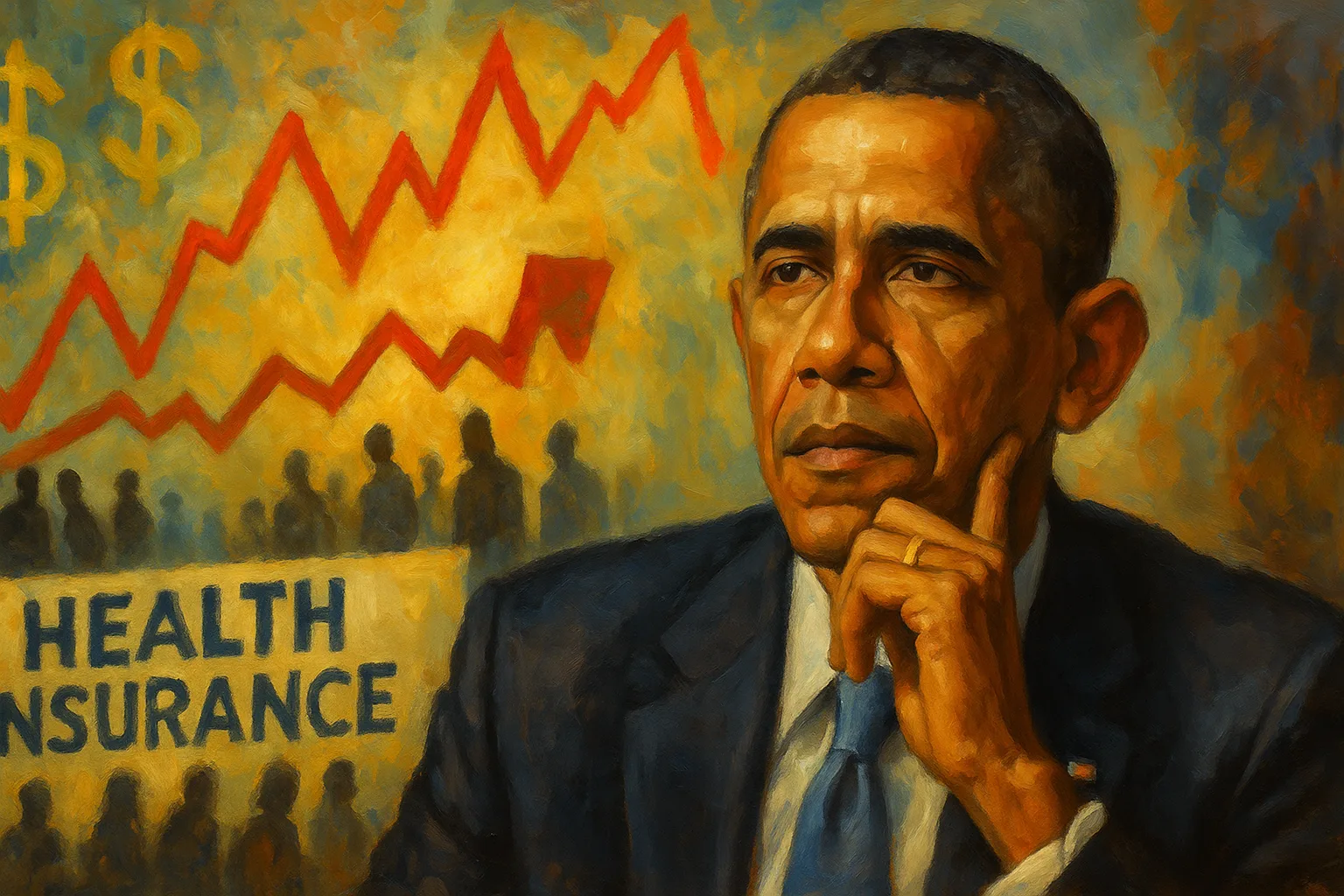When government collusion enriches corporations at the expense of citizens, health care becomes a business of control—not care.
The Great American Health Illusion
What was once billed as a humanitarian breakthrough has become one of the most profitable rackets in modern U.S. history. The Affordable Care Act (ACA), passed in 2010, promised affordability, transparency, and access. A decade later, premiums have more than doubled, deductibles have exploded, and insurance company stock prices have risen by more than 800%—some exceeding 1,000% since the law’s passage.
While politicians on both sides posture over “access to care,” the reality is that America’s health system has become a publicly subsidized profit engine for a handful of powerful corporations. UnitedHealth Group, Elevance (formerly Anthem), Cigna, Humana, and CVS/Aetna now dominate more than 75% of the private insurance market. Their gains come not from healing people—but from manipulating the regulatory code and transferring public funds into private balance sheets.
What was sold as reform became a controlled collapse—one that enriched insurers, hollowed out competition, and transformed citizens into permanent dependents within a system designed for profit extraction.
Obamacare’s Original Sin: Subsidies Masquerading as Care
At its core, the ACA institutionalized a government-backed subsidy pipeline to private insurers. Instead of reforming costs, it guaranteed them. By mandating participation and funding through tax credits, the federal government effectively insured the insurers—removing competitive pressure and moral accountability.
Between 2010 and 2023, the five largest insurance companies saw their market capitalization rise from under $100 billion to over $700 billion. Stock buybacks, CEO bonuses, and executive compensation soared, even as the average American’s out-of-pocket spending doubled.
Meanwhile, key architects and political champions of the law profited handsomely. Reports indicate that former President Barack Obama has collected more than $40 million in taxpayer-funded royalties linked to the Affordable Care Act since its passage (and continues to collect about $2.5 annually), underscoring how policy design and personal enrichment often intersect in Washington’s revolving-door economy.
Every legislative expansion—Medicaid enlargement, premium tax credits, or “risk corridor” payments—funneled more taxpayer money into corporate accounts.
The Shutdown Connection: Political Hostage-Taking and Subsidy Warfare
The current government shutdown once again exposes the parasitic relationship between Washington and corporate healthcare.
Budget fights over “health subsidies” are framed as moral battles between parties—but behind the rhetoric, both sides are protecting their own donor networks. Democrats fight to preserve subsidies that stabilize the insurance exchanges; Republicans decry them publicly, then quietly vote for bailout extensions through omnibus spending bills.
During shutdowns, millions of Americans face interruptions in healthcare programs, delayed reimbursements, and suspended oversight of insurer billing. Meanwhile, those same insurers continue receiving federal payments—insulated from the pain felt by the public.
The contrast is staggering: furloughed federal workers lose paychecks while corporations collect guaranteed income streams.
Each standoff reveals what few will admit: the U.S. healthcare system no longer serves the public good. It serves as an unbreakable feedback loop between lobbyists, lawmakers, and financial markets. And shutdowns are merely pressure tactics in that perpetual negotiation.
The Economics of Enrichment: Profits Up, Patients Down
Health insurance is now one of Wall Street’s most lucrative sectors. In 2010, UnitedHealth Group’s annual revenue was roughly $90 billion. In 2023, it exceeded $370 billion, with $23 billion in net profit. CVS Health (which acquired Aetna) reported over $11 billion in 2023 profit, buoyed by government contracts and pharmacy benefit schemes.
Stock prices across the top insurers have risen five- to tenfold, even as life expectancy in the United States continues to decline.
Where do the profits come from?
- Government subsidies and Medicare Advantage plans that pay insurers to manage care, while cutting access.
- Pharmacy benefit manager (PBM) monopolies that inflate drug prices while claiming to negotiate savings.
- Administrative inflation—charging more for doing less.
- Massive share buybacks financed by taxpayer subsidies.
The result is an economy where illness is monetized and recovery is discouraged. Healthcare costs now consume 18.3% of U.S. GDP, far higher than any developed nation—yet outcomes continue to worsen.
The Revolving Door: Regulatory Capture in Full View
The same officials who design health regulations frequently migrate into lucrative corporate roles. Former HHS secretaries, CMS administrators, and FDA commissioners sit on the boards of the very companies they once regulated. Lobbyists write the rules, lawmakers rubber-stamp them, and agencies enforce them selectively.
For instance:
- The Centers for Medicare & Medicaid Services (CMS) contracts heavily with UnitedHealth subsidiaries.
- The Federal Insurance Office, tasked with oversight, has repeatedly deferred to lobby recommendations from America’s Health Insurance Plans (AHIP).
- The Health and Human Services Inspector General has cited rampant waste and fraud in Medicare Advantage programs—yet penalties remain symbolic.
This is not oversight; it’s a revolving investment cycle. When private corporations influence the rules meant to restrain them, the public becomes the product.
The Smart Meter of Healthcare: Data, Control, and Forced Compliance
Healthcare’s digital revolution has brought another layer of invisible control. Electronic health records (EHRs), digital IDs, and biometric monitoring were promoted as efficiency tools. But in practice, they serve as data collection mechanisms feeding insurers, pharmaceutical firms, and government analytics.
Now, with AI-assisted diagnostics and wearable integration, the next stage is underway: health surveillance through frequency and behavior tracking.
Insurers already analyze smartphone and wearable data to adjust premiums or deny coverage based on “health compliance.” Federal agencies fund pilot programs linking patient data with predictive models of “risk behavior.”
Just as smart meters in homes transmit private data without consent, digital health networks now collect physiological data beyond the patient’s awareness. Privacy is gone; control is algorithmic. The citizen is no longer a participant in care—but a data node within a monetized ecosystem.
The Human Toll: A System of Debt and Despair
The American healthcare crisis is not abstract. It lives in every delayed appointment, every medical bill that triggers bankruptcy, every parent choosing between prescriptions and groceries.
- Medical debt remains the leading cause of bankruptcy, affecting more than 40% of U.S. households.
- Rural hospitals are closing at a record pace—over 200 since 2010.
- Suicide and chronic illness are on the rise, correlated with both financial strain and access denial.
- Administrative waste consumes 30 cents of every healthcare dollar, while nurses and doctors burn out under impossible workloads.
The people paying the most are those least able to afford it. A once-innovative system has devolved into a predatory bureaucracy that measures success not by lives saved, but by shareholder return.
The Global Shadow: From Healthcare to Health Control
The architecture of control isn’t limited to domestic policy.
Under global initiatives such as the World Health Organization’s “One Health” framework, international agencies are seeking greater authority over public health decisions. Coupled with digital ID programs and health passports introduced during the pandemic, this could cement a new tier of bio-administrative governance—a fusion of data, medicine, and political compliance.
Health sovereignty—the right to bodily autonomy, medical privacy, and personal decision-making—is quietly being eroded through legislation that ties access to compliance.
The pattern is identical to what we see in the insurance industry: centralization under the banner of safety, followed by profit extraction under the guise of efficiency.
Reclaiming Health Sovereignty
Rebuilding a system corrupted at its foundation begins with withdrawal from dependency. That means cultivating local, transparent, and people-centered care models—direct primary care, cooperatives, and independent practitioners who operate outside insurance networks.
Reforms must include:
- Eliminating subsidy pipelines to insurers and redirecting funds toward patients.
- Ending regulatory capture through mandatory conflict-of-interest audits.
- Protecting analog access—the right to pay privately or opt out of digital health mandates.
- Supporting medical freedom legislation that restores informed consent and personal choice.
True reform will not come from Washington. It will come from communities, doctors, and citizens refusing to be managed as data points in a corporate spreadsheet. Health sovereignty begins with reclaiming one’s body, choices, and dollars.
The System Is Working—Just Not for You
The U.S. healthcare system isn’t broken. It’s performing exactly as designed—for those who own it. What was framed as reform has become a shell game of subsidies, lobbyists, and revolving-door regulators. The shutdown isn’t the cause of collapse—it’s the symptom of a system that can’t exist without extortion, deceit, and moral compromise.
Until policy ceases to be written by those who profit from it, Americans will remain both the financiers and the victims of their own healthcare system. The betrayal is bipartisan, systemic, and ongoing. But exposure is the first step toward reclamation.
Share This Report
Have questions?
At Great Awakening Report, we are dedicated to supporting your journey toward truth and enlightenment through our specialized Coaching and Consulting services.
Coaching Services: Our coaching programs are designed to guide you through personal awakening and transformation. We offer personalized sessions that focus on expanding consciousness, uncovering hidden truths, and fostering spiritual growth. Our experienced coaches provide the tools and insights necessary to navigate your path with clarity and confidence.
Consulting Services: For organizations and individuals seeking deeper understanding and strategic guidance, our consulting services offer expert analysis and solutions. We delve into areas such as global transitions, alternative news insights, and consciousness studies to provide comprehensive strategies tailored to your unique objectives.
Embark on a transformative journey with our Coaching and Consulting services, and unlock your highest potential. To learn more and schedule a session, visit our Coaching and Consulting pages.
Thank you
Thank you to our subscribers and readers for your continued support and dedication to truth and awakening. Your encouragement, engagement, and belief in our mission make everything we do possible. Together, we are expanding awareness and helping illuminate the path forward.
If you would like to further support the Great Awakening team and our ongoing efforts to share insight, knowledge, and truth, you can DONATE HERE.
With deep gratitude,
– Great Awakening Team
DISCLAIMER: All statements, claims, views and opinions that appear anywhere on this site, whether stated as theories or absolute facts, are always presented by The Great Awakening Report (GAR) as unverified—and should be personally fact checked and discerned by you, the reader.Any opinions or statements herein presented are not necessarily promoted, endorsed, or agreed to by GAR, those who work with GAR, or those who read or subscribe to GAR.Any belief or conclusion gleaned from content on this site is solely the responsibility of you the reader to substantiate.Any actions taken by those who read material on this site are solely the responsibility of the acting party.You are encouraged to think for yourself and do your own research.Nothing on this site is meant to be believed without question or personal appraisal.
COPYRIGHT DISCLAIMER: Citation of articles and authors in this report does not imply ownership. Works and images presented here fall under Fair Use Section 107 and are used for commentary on globally significant newsworthy events. Under Section 107 of the Copyright Act 1976, allowance is made for fair use for purposes such as criticism, comment, news reporting, teaching, scholarship, and research.
COMMUNITY GUIDELINES DISCLAIMER: The points of view and purpose of this video is not to bully or harass anybody, but rather share that opinion and thoughts with other like-minded individuals curious about the subject.










